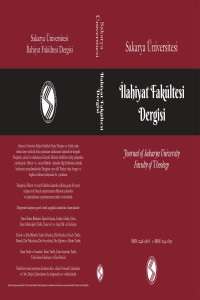Telkîbî Müsennânın Arapça Genel Sözlüklerdeki Varlığı: el-Muʽcemu’l-Vasît Örneği
The Presence of al-Muthannā al-Talqībī in General Arabic Dictionaries: The Case of al-Mu'jam al-wasīt
Author(s): Nazife Nihal İnce, Zeynep Sevde Akdoğan AnouSubject(s): Language studies, Language and Literature Studies, Studies of Literature
Published by: Sakarya üniversitesi
Keywords: Arabic Language and Rhetorics; Dictionary Entry; Muthannā; al-Muthannā al-Talqībī; al-Mu'jam al-wasīt;
Summary/Abstract: This article investigates the issue of duals, which differ from their singulars called al-muthannā al-talqībī, in the context of their inclusion as lexical items in general Arabic dictionaries. The study is limited to a modern dictionary: al-Mu'jam al-wasīt. The research is based on two interconnected assumptions: al-muthannā al-talqībīs are lexical items, and lexical items should be included in the dictionary entries. The research corpus comprises al-muthannā al-lughawī compilations with their bibliographies and al-Mu'jam al-wasīt entries. Although al-Mu'jam al-wasīt is one of the Arabic dictionaries written in recent history and is a modern dictionary in terms of form, it is known for following the classical sources in terms of content. In Arabic morphology, Muthannā is formed by adding a suffix to the end of the word to indicate that the entity it denotes is two in number. In other words, the structure of the noun+duality suffix signifies noun+noun, where each noun is identical to the other. Apart from the mentioned grammatical meaning, the muthannā form has been used to express ungrammatical meanings where each singular of the word is different from the other. These non-grammatical uses of muthannā called al-muthannā al-lughawī. The knowledge of non-grammatical muthannā is derived from the works of philologists. The philologists of the classical period wrote works compiling and classifying al-muthannā al-lughawī and its subcategories. al-Muthannā al-talqībī is one of these subcategories, describing a dual form in which two separate nouns are expressed via entirely different nouns. Since the meanings of such duals cannot be accessed from their singulars, it is logical for these words to appear in dictionary entries. Another reason why these words are expected to be included as entries in dictionaries is that they are very likely to be used in both classical and modern literature. Accordingly, there is a need for al-muthannā al-lughawī in general and al-muthannā al-talqībī in particular to be included as entries in general dictionaries. This research investigates the presence of these words in one of the largest dictionaries currently available: al-Mu'jam al-wasīt. Before collecting the data, a theoretical framework was established, including the general term muthannā, the place of al-muthannā al-lughawī in the literature, and the distinctive features of al-muthannā al-talqībī. Since very early times, alMuthannā al-lughawī has been considered a lexical item in independent works or in some comprehensive philological works, though the definitions and classifications of these words are seen in independent lexical collections. Based on these definitions, the distinctive features of almuthannā al-talqībī were determined. Recognizing the distinctive features of al-muthannā altalqībī has helped to resolve certain ambiguities and classification complexities that are found in the collections of al-muthannā al-lughawī. The data collection process of the research consisted of two steps. In the first step, a corpus was created by gathering the words in al-muthannā allughawī compilations, and the words were categorized and listed in terms of the relevance that formed the muthannā. Two types of relevance were found to be decisive in the formation of al-muthannā al-talqībī forms: epithet relevance and attributive relevance. In the second step, the presence of these corpus words in al-Muʽjam al-wasīt was investigated. The data was mainly analyzed quantitatively.
Journal: Sakarya Üniversitesi İlahiyat Fakültesi Dergisi (SAUIFD)
- Issue Year: 26/2024
- Issue No: 50
- Page Range: 651-674
- Page Count: 24
- Language: Turkish

